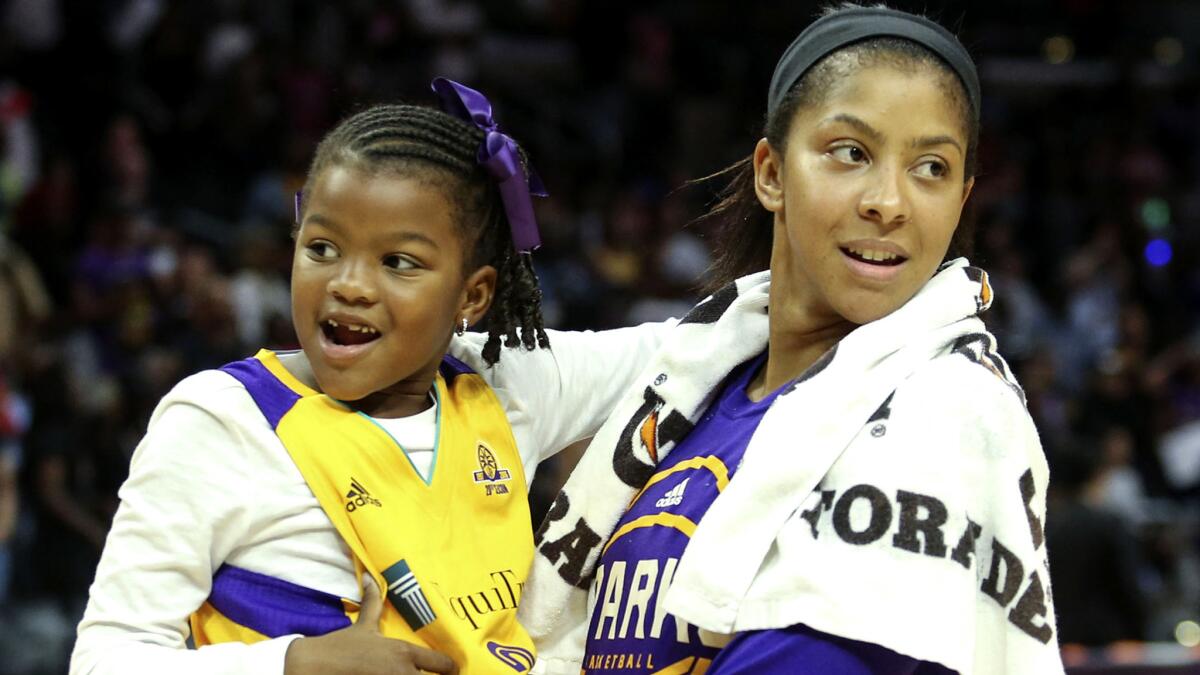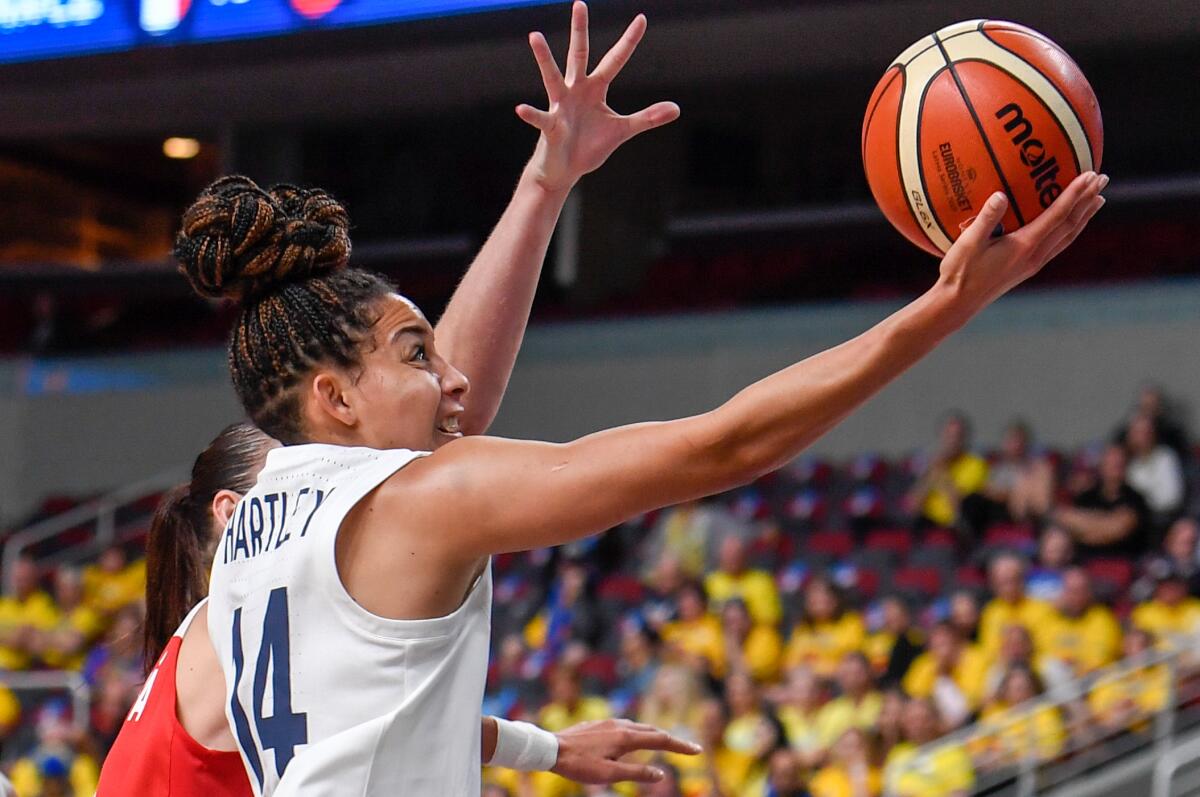How the WNBA improved conditions for players, particularly the moms

- Share via
Bria Hartley’s son was growing fast. The WNBA guard’s New York apartment was not.
When son Bryson outgrew the bassinet Hartley kept by her bed in her cramped one-bedroom apartment, the former New York Liberty guard moved his crib into the living room. A two-time NCAA champion at Connecticut, Hartley was still early in her career. There was no way she could afford the $1,500 upgrade for a second bedroom.
Three years later, the newly signed free agent won’t have to make the same sacrifice when joining the Phoenix Mercury.
Although the WNBA’s new collective bargaining agreement, announced in January, made headlines for significant salary increases for players, its expanded maternity benefits also earned praise for the way they illustrated the league’s dedication to investing in women. There are benefits for mothers at every stage, from those who are pregnant to those who have returned to the court and others hoping to start a family.
“Being a mom is a full-time job and it doesn’t stop because we are on the court,” said DeWanna Bonner, Connecticut Sun forward and mother of twins, in an email. “We actually worry more when we are away. So just providing the small things around the league to ease our minds a little is a huge help.”
Although the league will hold its draft remotely on Friday, the start of training camps (originally April 26) and the regular season (May 15) are on hold during the COVID-19 pandemic.
Players, though, will now be guaranteed their full salaries while on maternity leave. Teams will provide two-bedroom units for players living with their children under 13. Mothers are guaranteed “comfortable, safe, private” places to nurse and access to refrigeration for breast milk. Players have a $5,000 annual stipend for childcare, and those with eight or more years are eligible for up to $20,000 a year to cover costs related to adoption, surrogacy, freezing their eggs, or fertility and infertility treatment, with up to $60,000 in family-planning allowed in a player’s career.
Securing higher pay and better working conditions, especially while traveling, were main priorities of the players union’s nearly two-year negotiating process, but the additional maternity benefits made negotiators the most proud.
“Everybody has called it a groundbreaking CBA, and the more distance I get from the agreement and the nature of what we accomplished, the more I feel like it wasn’t groundbreaking. It was ground-establishing,” said Sparks forward Chiney Ogwumike, president of the players association’s executive committee. “Because for women to have an opportunity to get paid on maternity leave, why is that something novel? Every woman around the country and around the world can identify with that.”
The comprehensive benefits in the new CBA were no-brainers for Cathy Engelbert. Before becoming the WNBA’s first commissioner last year — previous top executives were called presidents — Engelbert was the first female CEO at Deloitte and instituted wide-ranging maternity benefits, including a 16-week family leave policy, at the company.
A look at how sports leagues, including the NFL, MLB, MLS, NBA and NHL, are responding to the coronavirus outbreak.
Engelbert said she wanted a platform to advocate for women in her new job. She accomplished that with the WNBA’s historic agreement.
“If we’re really on the forefront of social issues, we need to make sure we’re putting our money where our mouth is, and that’s where Cathy Engelbert was great,” said Layshia Clarendon, Liberty guard and first vice president of the player association’s executive committee. Engelbert said that there was “no doubt we’re paying our players,” Clarendon said. With a “league full of women,” the commissioner stressed that you’re not going to “mommy-tax” the women, Clarendon said.
Players were guaranteed at least 50% of their salaries while on maternity leave under the previous CBA, but some organizations still paid players in full. The uncertainty left Hartley, who was entering her third year with the Washington Mystics when she learned she was pregnant in 2016, reluctant to tell her organization she was pregnant. She was a role player. There was always another player who could take her spot.
“I know this is still a business at the end of the day,” said Hartley, who added that she received her full salary while sitting out the final 10 games of the season.

With the CBA’s new policies, there’s no reason this business can’t benefit mothers also, Hartley believes. With family planning and fertility options, players won’t have to feel like they are sacrificing an opportunity to have children by playing, Hartley said. Bonner said she’d heard more talk about players taking advantage of those benefits to start families.
With players like Bonner, who returned from childbirth to have back-to-back All-Star seasons, and Candace Parker, a two-time MVP, five-time All-Star and mother to 10-year-old daughter Lailaa, organizations don’t need to worry about players’ ability to return to top form.
“It just shows how powerful women are,” Hartley said. “Not only can we dominate in our sport but we can start families and be really good at that as well. There’s no reason to say one limits the other.”
More to Read
Go beyond the scoreboard
Get the latest on L.A.'s teams in the daily Sports Report newsletter.
You may occasionally receive promotional content from the Los Angeles Times.












